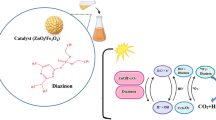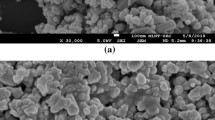Abstract
Purpose
Bisphenol A (BPA), as endocrine-disrupting compound (EDC), is extensively used as an important chemical in the synthesis of polycarbonate polymers and epoxy resins. BPA absorption into the body can result in the development of metabolic disorders such as low sex-specific neurodevelopment, immune toxicity, neurotoxicity and interference of cellular pathway. Therefore, the presence of BPA in the body and the environment can create hazards that must reach standards before being discharged into the environment.
Methods
In this study, bismuth ferric nanomagnetic (BFO NMPs) were successfully synthesized via sol-gel method and developed as photocatalysts for BPA removal under visible light irradiation. FE-SEM, TEM, PL, XRD, UV-Vis DRS, VSM, EDX, and FTIR were used to characterize the BFO NMPs.
Results
RSM model (R2 = 0.9745) showed a good correlation between experimental and predicted removal efficiency of BPA. The investigation of four independent variables indicated that pH had the most significant positive effect on the degradation of BPA. Under optimal conditions (pH = 4.042, catalyst dose = 7.617 mg, contact time = 122.742 min and BPA concentration = 15.065 mg/L), maximum degradation was calculated to be 98.7%. After five recycles, the removal of BPA remained >82%, which indicated the proper ability to reuse the catalyst.
Conclusion
In conclusion, it can be stated like BPA, the prepared BFO NMPs is a promising photocatalyst for practical application in organic pollutant decomposition.






Similar content being viewed by others
References
Mahvi AH, et al. Photo-oxidation of phenol in aqueous solution: toxicity of intermediates. Korean J Chem Eng. 2007;24(1):79–82.
Bazrafshan E, Biglari H, Mahvi AH. Phenol removal by electrocoagulation process from aqueous solutions. Fresenius Environ Bull. 2012;21(2):364–71.
Biglari H, et al. A review and investigation of the effect of nanophotocatalytic ozonation process for phenolic compound removal from real effluent of pulp and paper industry. Environ Sci Pollut Res. 2017;24(4):4105–16.
Maleki A, et al. Degradation and toxicity reduction of phenol by ultrasound waves. Bull Chem Soc Ethiop. 2007;21(1).
Bazrafshan E, Mostafapour FK, Mahvi AH. Phenol removal from aqueous solutions using pistachio-nut shell ash as a low cost adsorbent. Fresenius Environ Bull. 2012;21(10):2962–8.
Davididou K, et al. Photocatalytic degradation of bisphenol-a under UV-LED, blacklight and solar irradiation. J Clean Prod. 2018;203:13–21.
Nikfar E, et al. Removal of bisphenol a from aqueous solutions using ultrasonic waves and hydrogen peroxide. J Mol Liq. 2016;213:332–8.
Liao C, Kannan K. Concentrations and profiles of bisphenol a and other bisphenol analogues in foodstuffs from the United States and their implications for human exposure. J Agric Food Chem. 2013;61(19):4655–62.
Abo R, Kummer N-A, Merkel BJ. Optimized photodegradation of bisphenol a in water using ZnO, TiO 2 and SnO 2 photocatalysts under UV radiation as a decontamination procedure. Drinking Water Engineering and Science. 2016;9(2):27–35.
Calafat AM, et al. Exposure of the US population to bisphenol a and 4-tertiary-octylphenol: 2003–2004. Environ Health Perspect. 2008;116(1):39–44.
Pelch K, et al. A scoping review of the health and toxicological activity of bisphenol a (BPA) structural analogues and functional alternatives. Toxicology. 2019;424:152235.
Dehghani MH, et al. Adsorption of bisphenol a (BPA) from aqueous solutions by carbon nanotubes: kinetic and equilibrium studies. Desalin Water Treat. 2015;54(1):84–92.
Bechambi O, Sayadi S, Najjar W. Photocatalytic degradation of bisphenol a in the presence of C-doped ZnO: effect of operational parameters and photodegradation mechanism. J Ind Eng Chem. 2015;32:201–10.
Reddy PVL, et al. Photocatalytic degradation of bisphenol a in aqueous media: a review. J Environ Manag. 2018;213:189–205.
Abraham A, Chakraborty P. A review on sources and health impacts of bisphenol a. Rev Environ Health. 2020;35(2):201–10.
Gao B, et al. Zr-doped TiO2 for enhanced photocatalytic degradation of bisphenol a. Appl Catal A Gen. 2010;375(1):107–15.
Wang, X. and T.-T. Lim, Solvothermal synthesis of C–N codoped TiO2 and photocatalytic evaluation for bisphenol A degradation using a visible-light irradiated LED photoreactor. Appl Catal B Environ, 2010. 100(1): p. 355–364.
Asadgol Z, et al. Removal of phenol and bisphenol-a catalyzed by laccase in aqueous solution. J Environ Health Sci Eng. 2014;12(1):1–5.
Chen J, Huang X, Lee D. Bisphenol a removal by a membrane bioreactor. Process Biochem. 2008;43(4):451–6.
Dong Y, et al. Adsorption of bisphenol a from water by surfactant-modified zeolite. J Colloid Interface Sci. 2010;348(2):585–90.
Mita L, et al. Bisphenol a removal by a Pseudomonas aeruginosa immobilized on granular activated carbon and operating in a fluidized bed reactor. J Hazard Mater. 2015;291:129–35.
Deborde M, et al. Oxidation of bisphenol a by ozone in aqueous solution. Water Res. 2008;42(16):4299–308.
Dehghan A, et al. Adsorption and visible-light photocatalytic degradation of tetracycline hydrochloride from aqueous solutions using 3D hierarchical mesoporous BiOI: synthesis and characterization, process optimization, adsorption and degradation modeling. Chem Eng Res Des. 2018;129:217–30.
Dong W, et al. Excellent photocatalytic degradation activities of ordered mesoporous anatase TiO2–SiO2 nanocomposites to various organic contaminants. J Hazard Mater. 2012;229-230:307–20.
Saravanan R, et al. Enhanced photocatalytic activity of ZnO/CuO nanocomposite for the degradation of textile dye on visible light illumination. Mater Sci Eng C. 2013;33(1):91–8.
Gupta VK, et al. Removal of the hazardous dye—Tartrazine by photodegradation on titanium dioxide surface. Mater Sci Eng C. 2011;31(5):1062–7.
Pattnaik SP, et al. Synthesis, photoelectrochemical properties and solar light-induced photocatalytic activity of bismuth ferrite nanoparticles. J Nanopart Res. 2018;20(1):10.
Soltani T, Entezari MH. Solar photocatalytic degradation of RB5 by ferrite bismuth nanoparticles synthesized via ultrasound. Ultrason Sonochem. 2013;20(5):1245–53.
Lu H, et al. Enhanced photocatalytic performance of ag-decorated BiFeO3 in visible light region. J Sol-Gel Sci Technol. 2015;76(1):50–7.
Ponraj C, V G, Daniel J. A review on the visible light active BiFeO3 nanostructures as suitable photocatalyst in the degradation of different textile dyes. Environmental Nanotechnology, Monitoring & Management. 2017;7:110–20.
Dehghani MH, et al. Removal of methylene blue dye from aqueous solutions by a new chitosan/zeolite composite from shrimp waste: kinetic and equilibrium study. Korean J Chem Eng. 2017;34(6):1699–707.
Dehghani MH, Dehghan A, Najafpoor A. Removing reactive red 120 and 196 using chitosan/zeolite composite from aqueous solutions: kinetics, isotherms, and process optimization. J Ind Eng Chem. 2017;51:185–95.
Karami A, et al. Application of response surface methodology for statistical analysis, modeling, and optimization of malachite green removal from aqueous solutions by manganese-modified pumice adsorbent. Desalin Water Treat. 2017;89:150–61.
Soltani T, Lee B-K. Sono-synthesis of nanocrystallized BiFeO3/reduced graphene oxide composites for visible photocatalytic degradation improvement of bisphenol a. Chem Eng J. 2016;306:204–13.
Liu Y, et al. A novel synergy of Er3+/Fe3+ co-doped porous Bi5O7I microspheres with enhanced photocatalytic activity under visible-light irradiation. Appl Catal B Environ. 2017;205:421–32.
Mohapatra DP, et al. Parameter optimization of ferro-sonication pre-treatment process for degradation of bisphenol a and biodegradation from wastewater sludge using response surface model. J Hazard Mater. 2011;189(1):100–7.
Khataee AR, et al. Optimization of photocatalytic treatment of dye solution on supported TiO2 nanoparticles by central composite design: intermediates identification. J Hazard Mater. 2010;181(1):886–97.
Mosleh S, et al. Photocatalytic degradation of binary mixture of toxic dyes by HKUST-1 MOF and HKUST-1-SBA-15 in a rotating packed bed reactor under blue LED illumination: central composite design optimization. RSC Adv. 2016;6(21):17204–14.
Vaez M, Zarringhalam Moghaddam A, Alijani S. Optimization and modeling of photocatalytic degradation of azo dye using a response surface methodology (RSM) based on the central composite design with immobilized Titania nanoparticles. Ind Eng Chem Res. 2012;51(11):4199–207.
Soleymani AR, et al. Modeling and optimization of a sono-assisted photocatalytic water treatment process via central composite design methodology. Process Saf Environ Prot. 2015;94:307–14.
Amalraj Appavoo I, et al. Response surface modeling of carbamazepine (CBZ) removal by graphene-P25 nanocomposites/UVA process using central composite design. Water Res. 2014;57:270–9.
Liu H-L, Chiou Y-R. Optimal decolorization efficiency of reactive red 239 by UV/TiO2 photocatalytic process coupled with response surface methodology. Chem Eng J. 2005;112(1):173–9.
Xue Z, et al. Degradation of tetracycline with BiFeO3 prepared by a simple hydrothermal method. Materials (Basel, Switzerland). 2015;8(9):6360–78.
Gao F, et al. Visible-light photocatalytic properties of weak magnetic BiFeO3 nanoparticles. Adv Mater. 2007;19(19):2889–92.
Soltani T, Entezari MH. Photolysis and photocatalysis of methylene blue by ferrite bismuth nanoparticles under sunlight irradiation. J Mol Catal A Chem. 2013;377:197–203.
Gao T, et al. Synthesis of BiFeO3 nanoparticles for the visible-light induced photocatalytic property. Mater Res Bull. 2014;59:6–12.
Senthilnathan J, Philip L. Photocatalytic degradation of lindane under UV and visible light using N-doped TiO2. Chem Eng J. 2010;161(1):83–92.
Hao C, et al. Photocatalytic performances of BiFeO3 particles with the average size in nanometer, submicrometer, and micrometer. Mater Res Bull. 2014;50:369–73.
Huo Y, Jin Y, Zhang Y. Citric acid assisted solvothermal synthesis of BiFeO3 microspheres with high visible-light photocatalytic activity. J Mol Catal A Chem. 2010;331(1–2):15–20.
Seck EI, et al. Photocatalytic removal of 2,4-dichlorophenoxyacetic acid by using sol–gel synthesized nanocrystalline and commercial TiO2: operational parameters optimization and toxicity studies. Appl Catal B Environ. 2012;125:28–34.
Khataee AR, Kasiri MB, Alidokht L. Application of response surface methodology in the optimization of photocatalytic removal of environmental pollutants using nanocatalysts. Environ Technol. 2011;32(15):1669–84.
Zhu H, et al. Effective photocatalytic decolorization of methyl orange utilizing TiO2/ZnO/chitosan nanocomposite films under simulated solar irradiation. Desalination. 2012;286:41–8.
Cao C, et al. Visible-light photocatalytic decolorization of reactive brilliant red X-3B on Cu2O/crosslinked-chitosan nanocomposites prepared via one step process. Appl Surf Sci. 2013;271:105–12.
Wang H, et al. Preparing a photocatalytic Fe doped TiO2/rGO for enhanced bisphenol a and its analogues degradation in water sample. Appl Surf Sci. 2020;505:144640.
Chiang K, et al. Photocatalytic degradation and mineralization of bisphenol a by TiO2 and platinized TiO2. Appl Catal A Gen. 2004;261(2):225–37.
Hunge Y, et al. Photocatalytic degradation of bisphenol a using titanium dioxide@ nanodiamond composites under UV light illumination. J Colloid Interface Sci. 2021;582:1058–66.
Soltani T, Tayyebi A, Lee B-K. Quick and enhanced degradation of bisphenol a by activation of potassium peroxymonosulfate to SO4− with Mn-doped BiFeO3 nanoparticles as a heterogeneous Fenton-like catalyst. Appl Surf Sci. 2018;441:853–61.
Li L, et al. Enhanced mineralization of bisphenol a by eco-friendly BiFeO3–MnO2 composite: performance, mechanism and toxicity assessment. J Hazard Mater. 2020;399:122883.
Chu Y, et al. Fabrication of flower-globular Bi2WO6/BiOI@ Ag3PO4 photocatalyst for the degradation of bisphenol a and cefepime under sunlight: photoelectric properties, degradation performance, mechanism and biodegradability enhancement. Sep Purif Technol. 2021;272:118866.
Mengting Z, et al. 2D graphene oxide (GO) doped pn type BiOI/Bi2WO6 as a novel composite for photodegradation of bisphenol a (BPA) in aqueous solutions under UV-vis irradiation. Mater Sci Eng C. 2020;108:110420.
Li X, et al. Application of pea-like yolk–shell structured Fe 3 O 4@ TiO 2 nanosheets for photocatalytic and photo-Fenton oxidation of bisphenol-a. RSC Adv. 2019;9(38):22153–60.
Garg A, et al. Photocatalytic degradation of bisphenol-a using N, co Codoped TiO 2 catalyst under solar light. Sci Rep. 2019;9(1):1–13.
Jiao Z, et al. Degradation of bisphenol a by CeCu oxide catalyst in catalytic wet peroxide oxidation: efficiency, stability, and mechanism. Int J Environ Res Public Health. 2019;16(23):4675.
Nguyen, T.B., C. Huang, and R.-a. Doong, Photocatalytic degradation of bisphenol a over a ZnFe2O4/TiO2 nanocomposite under visible light. Sci Total Environ, 2019. 646: p. 745–756.
Zhu Y, et al. Efficient activation of persulfate by Fe 3 O 4@ β-cyclodextrin nanocomposite for removal of bisphenol a. RSC Adv. 2018;8(27):14879–87.
Acknowledgements
This study was funded by Tehran University of Medical Sciences (TUMS), Institute for Environmental Research with research code of 96-03-46-36266. Hence, the authors would like to express their gratitude for this support.
Author information
Authors and Affiliations
Corresponding author
Ethics declarations
Conflict of interest
All authors certify that they have no affiliations with or involvement in any organization or entity with any financial interest or non-financial interest in the subject matter or materials discussed in this manuscript.
Additional information
Publisher’s note
Springer Nature remains neutral with regard to jurisdictional claims in published maps and institutional affiliations.
Rights and permissions
About this article
Cite this article
Mahmoudian, M.H., Mesdaghinia, A., Mahvi, A.H. et al. Photocatalytic degradation of bisphenol a from aqueous solution using bismuth ferric magnetic nanoparticle: synthesis, characterization and response surface methodology-central composite design modeling. J Environ Health Sci Engineer 20, 617–628 (2022). https://doi.org/10.1007/s40201-021-00762-2
Received:
Accepted:
Published:
Issue Date:
DOI: https://doi.org/10.1007/s40201-021-00762-2




